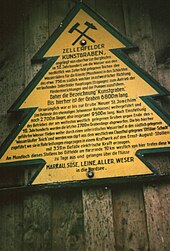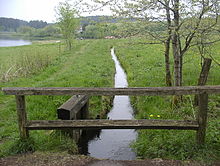Zellerfelder Kunstgraben

The Zellerfeld artificial ditch is an artificially created ditch in the Upper Harz and part of the Upper Harz water shelf . Its main task was to supply water to the pits of the middle Zellerfeld corridor train .
History and course
In order to supply the pits of the Zellerfeld corridor train with sufficient impact water, the Zellerfeld artificial ditch was built before 1673. The ditch led its water to a so-called division at the inlet mouth of the Winterwieser watercourse . From there it could either be directed southwards through the Winterwieser watercourse, initially underground and then via a partially covered ditch to the central colliery pond, which could lead it to the rainbow pit. Alternatively, there was the possibility of feeding the water further west to the Joachim pit.
In the middle of the 19th century , the ditch, which ran largely parallel to the contour lines, had a total length of 4867 Lachtern (9363 meters), of which 550 meters belonged to the Winterwieser watercourse . He obtained his water mainly from the Spiegelbach and the Schalke ; it could be temporarily stored in the Mittlerer Kellerhalsteich (1724) and especially in the Kiefhölzer pond (before 1671).
At the end of the 19th century, the 2700 meter long section to the Joachim pit (or Neuer St. Joachim ) was dropped after operations at the pits furthest to the west had ceased. The total length was then about 6,800 meters.
After mining in Zellerfeld was shut down in 1930, the water from the trench was conducted via a pipeline through the Zellerfeld valley in 1940 and fed to the Ottiliae shaft , where a hydropower plant was located at a depth of around 360 meters until 1980. In 1944, water extraction was extended further north by creating a new connection via pipes, watercourses and, in some cases, new ditches from the Upper Grumbacher Pond to the beginning of the Zellerfeld artificial ditch at the Middle Kellerhalsteich. This route was using existing structures, but mostly in operation with a reversal of the direction of flow until 1980. The water used in the Ottiliae shaft power plant then flowed off to the edge of the Harz via the Ernst August tunnel .
As part of the entertainment of the Upper Harz Water Regale the Zellerfelder art trench is still on the line between Kiefhölzer pond and winter Wieser watercourse of the resin waterworks operated and supplied with water. The hydraulic capacity of the trench is around 200 liters per second. The mean gradient between the Mittlerer Kellerhalsteich and the inlet into the Winterwieser watercourse is about 1.65 ‰; this corresponds to a height difference of 1.65 meters per kilometer.
Arches
The vaulted arches above the moat are striking in the area of the road maintenance depot southeast of the Stadtweger pond. These arches made of greywacke natural stone existed in considerably more trenches up to the beginning of the 20th century. They served as a support for a cover of the trench in winter, which should act as frost protection. In many of the trenches, however, the fighter stones can be seen at least on both sides, which are built into the dry masonry at a distance of about 2.5 meters.
See also
Individual evidence
- ↑ a b Dennert-Tanne 146.Retrieved on November 30, 2015 .
- ↑ Dumreicher: Entire overview of the water management of the north-western Upper Harz. 1868, p. 27.
- ↑ Dumreicher: Entire overview of the water management of the north-western Upper Harz. 1868, p. 28.
- ^ Preussag AG: Water rights applications for the Upper Harz water shelf , unpublished, Goslar 1964
- ↑ Martin Schmidt : The water management of the Upper Harz mining (= publication series of the Frontinus Society . Issue 13). 3rd supplemented edition. Harzwasserwerke, Hildesheim 2002, ISBN 3-00-009609-4 .
literature
- Justus Teicke: UNESCO World Heritage Upper Harz Water Management - The Upper Harz Water Shelf, the most important pre-industrial energy generation and supply system in the world . Harzwasserwerke, Clausthal-Zellerfeld 2011 (24 p., Harzwasserwerke.de [PDF; 2.8 MB ]).
- U. Dumreicher: Entire overview of the water management of the north-western Upper Harz . Verlag der Grosse'schen Buchhandlung, Clausthal 1868.
- Wilfried Ließmann : Historical mining in the Harz . 3. Edition. Springer, Berlin 2010, ISBN 978-3-540-31327-4 .

